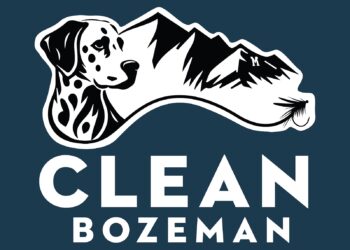DNRC calls potential underwater utility lines ‘safe depth’ as developer seeks permitting
By Jessianne Castle EBS ENVIRONMENTAL & OUTDOORS EDITOR
BOZEMAN – A landowner on the Gallatin River near Gallatin Gateway is seeking to develop his property into a riverside “glampground,” eliciting concern from his neighbors. The proposed “Riverbend Glamping Getaway” would offer a riverside stay in one of 37 canvas wall tents or 20 Conestoga wagons near the town of Gallatin Gateway, population 850.
According to the project’s developer Jeff Pfeil, the glamping resort is intended to connect people with nature and make the camping experience more accessible without requiring a person to have a camper or tent gear. Each wall tent and wagon would include a bathroom and small kitchenette and the property would also include a tiki bar, patio lounge and children’s playground.
As Pfeil seeks the necessary permits to develop his site, which would require several land- and water-use permits that authorize installing natural gas, fiberoptic and sewer lines beneath the Gallatin River, neighbors and concerned citizens have filed more than 250 complaints against the proposal.
While progress is stalled as several state agencies, the Gallatin County Department of Planning and Community Development, and Gallatin Conservation District consider Pheil’s permit applications, emotions are running high on the Gallatin.
Floodplain woes
“It’s representative of a lot of common issues that seem to be going on in Montana,” said Megan Buecking, a former Big Sky School District art teacher who lives near the property proposed for the glampground. “You see how much development is going on. I think people need to be really cognizant of how it’s affecting the environment.”
Buecking added that ultimately the development isn’t the problem, pointing out that tourism has allowed the Bozeman area to grow and prosper, but Buecking calls for “thoughtful growth.” Among her chief concerns for the Gallatin glampground is the fact that the site exists on an island in the Gallatin River that’s prone to flood.
In January 2019, Pfeil purchased approximately 16 acres of land west of Gallatin Gateway’s downtown. The land is adjacent to Gateway South Road in a place where the Gallatin River splits into an east and west channel. There are three landowners with property on the so-called Gallatin island on the north side of Gateway South Road: Pfeil, Dick and Donna Shockley, and Peggy and Gordon Lehmann.
“The Gallatin River is a source of such great pride and prosperity to Montana,” Dick Shockley said. “There are so many concerns and it’s in the floodplain. There is some [land] that’s above the floodplain, but historically it has been flooded.”
Shockley, who has resided in his home west of the Pfeil place for 45 years, says he’s seen the Gallatin River flood it’s banks and sweep across his property numerous times, even washing away garden beds and flooding Gateway South Road. “I’m here to tell you that when the Gallatin floods, it’s a huge force.”
Shockley, Buecking and the Lehmanns have expressed concern over the fact that in order to provide municipal wastewater services and utility hookup, NorthWestern Energy will have to bore underneath the east channel of the Gallatin River and run a line for natural gas and an additional line will be installed for fiberoptic and wastewater.
“It’s one thing to be concerned about this project,” Shockley said, “but it sets a precedent. What if something similar comes up down the road or up in the [Gallatin] Canyon?”
During floods, Buecking explained, fast-moving water erodes sediment and can expose buried lines, leaving the potential that effluent could seep into the river. Shockley added that with the proposed number of sites, some 200 people could be concentrated on 16 acres, leading to plastic liter in the Gallatin and a disturbance to the wildlife that live on the land, which has historically been used as cow pasture.
Due diligence
Pfeil, who has lived in Bozeman for 20 years, hired engineering professionals to ensure the development is in accordance with the law and guide him through obtaining the necessary permits.
“At the end of it all, my wife and I are very avid outdoors people,” he said. “I’m an entrepreneur at heart and it felt like a fun way to share the outdoors with others. People are not as connected to nature and they grow farther away from it every day.”
Ultimately, Pfeil said the Gallatin River would be the highlight of the camping stay. “The river is the recreation,” he said. “[It’s] right out the front door so we’d never hurt it.”
Pfeil added that currently trash and debris gather all along the banks of the Gallatin, but he intends to maintain his streamside and keep it clean. “Regular maintenance is going to be an obvious part of our business model and stewardship plan.”
Additionally, Pfeil said the tent sites will be placed in an area of the property that was recently reassessed as occurring above the floodplain. The tents will be on pads built 2 feet above the existing grade. The sites for the Conestoga wagons, which fall within the floodplain, will be fitted with quick-connect utility lines so they can be moved in the event of an imminent flood.
In order to supply utilities to the campsites, Pfeil and NorthWestern Energy have applied to install lines under the Gallatin River. It’s a move Pfeil says is far better than relying on septic tanks that must be frequently maintained and could seep effluent in the event of a flood.
Jo Dee Black, a spokeswoman for NorthWestern Energy, said the utility is obliged to serve the energy needs of its customers. “As with all our natural gas lines, they are non-liquid carrying infrastructure,” she wrote in an email to EBS. “Natural gas lines under a river or stream bed are often in a floodplain, which requires permitting from the municipal jurisdiction.”
The Montana Department of Natural Resources and Conservation as well as the Gallatin County Planning Department are currently reviewing Pfeil and NorthWestern Energy’s applications to install the lines 10 feet below the streambed.
DNRC Public Information Officer John Grassy said these kinds of requests are not unusual. “There are utility lines that run under a number of rivers and streams in the state,” Grassy said. “Ten feet is regarded as a pretty safe depth in terms of dealing with changing river conditions.”














